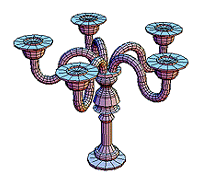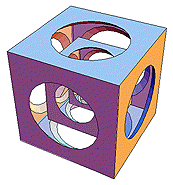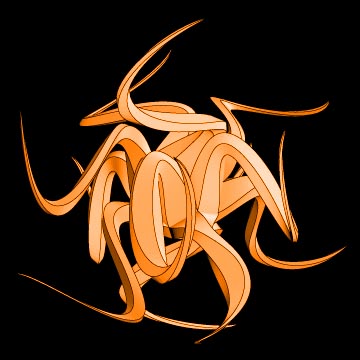

Mathematica is a sophisticated numerical, symbolic and graphics system. Here are some examples of the graphics that can be generated (calculated) using this program.




These and other examples can be found at Wolfram Research Inc.
I was reading a story about the Tour de France, the world's most famous bicycle race, on the Internet at:
Miguel Indurain of Spain, winner of the last five Tour de France races, needless to say is in excellent shape. A couple interesting facts about his physical condition are that he:
Wow! Test yourself sometime and see how you compare.
Hersh, Philip, `Indurain points to 5 straight', ESPNet.SportsZone.com, 9 July 1995.
For many years an enzyme called horseradish peroxidase has been known to convert phenols to non-toxic byproducts. Phenols are commonly found in some industrial wastewaters and is difficult to treat. This enzyme together with peroxide will form polymers that can easily be filtered out of water. The assumption had always been that horseradish peroxidase had to be added in a purified form and that that would be prohibitively expensive. Investigators at Pennsylvania State University have run experiments that show that ordinary minced horseradish knocks phenols out of wastewater in 30 minutes and can be reused up to 30 times. In fact, horseradish is more effective than minced potato and white radish, two other inexpensive phenol-fighting compounds tested.
Brittan, D., `Phenomena', TechnologyReview, July 1995, p. 72.
Researchers affiliated with the University of Georgia's Savannah River Ecology Laboratory have been studying the effects of the Chernobyl nuclear disaster in the Ukraine. They have found that many animals have undergone mutations of various types amounting to more than 10 million years worth of natural mutations. Wildlife in the area has been flourishing, especially the mice. Researchers found that while Chernobyl mice don't look like mutants they have many breaks in their DNA strands. The scientists examined a gene in the DNA called cytochrome B that, because it is passed directly from mother to offspring and changes slowly, is considered a genetic clock. Comparison of this gene from mice around Chernobyl to that of mice outside the area showed surprising results. Gene sequences, as well as their proteins, were all different in the two groups of mice. In fact, the difference in the genes between normal mice and the Chernobyl mice was greater than that found between mice and rats, species that diverged some 15 million years ago. What surprised scientists was the large numbers of mice found in the area. Despite the genetic changes, the mice seem to be doing better than other species, including humans who are suffering high cancer rates.
`Mutant mice thrive at Chernobyl', UPI - Washington, D.C., July 9, 1995.
A great source for sports news can be found at:
A link to (The American Association for the Advancement of) SCIENCE can now be found on the Internet at: